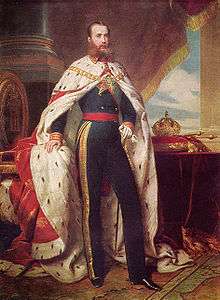Emperor of Mexico
The Emperor of Mexico (Spanish: Emperador de México) was the head of state and ruler of Mexico on two non-consecutive occasions in the 19th century.
| Emperor of Mexico | |
|---|---|
Imperial | |
.svg.png) | |
.jpg) | |
| Details | |
| Style | His Imperial Majesty |
| First monarch | Agustín I |
| Last monarch | Maximilian I |
| Formation | 19 May 1822 |
| Abolition | 15 May 1867 |
| Residence | Palace of Moncada (1822-1823)
Chapultepec Castle (1864-1867) |
| Appointer | Hereditary |
| Pretender(s) | Count Maximilian von Götzen-Iturbide |
With the Declaration of Independence of the Mexican Empire from Spain in 1821, Mexico became an independent monarchy—the First Mexican Empire (1822–1823). Mexico briefly reverted into a monarchy in the 1860s, during the Second Mexican Empire (1864–1867). In both instances of Empire, the reigning Emperor was forcibly deposed and then executed.
First Mexican Empire (1821–1823)
| Name | Lifespan | Reign start | Reign end | Notes | Family | Image |
|---|---|---|---|---|---|---|
| Agustín I | 27 September 1783 – 19 July 1824 (aged 40) | 19 May 1822 | 19 March 1823 | Iturbide |
Decree
The Sovereign Mexican Constituent Congress decreed on June 22, 1822[1] the following:
- Art 1 °. The Mexican Monarchy, in addition to being moderate and Constitutional, is also hereditary.
- Art 2 °. Consequently, the Nation calls the succession of the Crown for the death of the current Emperor, his firstborn son Don Agustín Jerónimo de Iturbide. The Constitution of the Empire will decide the order of succession of the throne.
- Art 3 °. The crown prince will be called "Prince Imperial" and will have the treatment of Imperial Highness.
- Art 4 °. The legitimate sons and daughters of H.I.M will be called "Mexican Princes", and will have the treatment of Highness.
- Art 5 °. Don José Joaquín de Iturbide y Arreguí, Father of H.I.M, is decorated with the title of "Prince of the Union" and the treatment of Highness, during his life.
- Art 6 °. It is also granted the title of "Princess of Iturbide" and the treatment of Highness, during his life, to Doña María Nicolasa de Iturbide y Arámburo, sister of the Emperor.
Second Mexican Empire (1863–1867)
| Name | Lifespan | Reign start | Reign end | Notes | Family | Image |
|---|---|---|---|---|---|---|
| Maximilian I | 6 July 1832 – 19 June 1867 (aged 34) | 10 April 1864 | 15 May 1867 | Habsburg-Lorraine |  |
Decree
The Superior Government Junta by the Conservative Party decreed on July 11 of 1863[2] the following:
- Art 1 °. The Mexican nation adopts a moderated, hereditary monarchy by way of government, with a Catholic prince.
- Art 2 °. The sovereign will take the title of Emperor of Mexico.
- Art 3 °. The imperial crown of Mexico is offered to S. A. and R., Prince Maximilian, archduke of Austria, for himself and his descendants.
- Art 4 °. In the event that, due to circumstances impossible to foresee, Archduke Maximilian did not take possession of the throne that is offered, the Mexican nation refers to the benevolence of HM Napoleon III, emperor of the French, to be instructed by another Catholic prince.
gollark: Cheap hypercomputers.
gollark: Yes, due to lyric bad.
gollark: Olivia is in fact an early adopter, and is using an Olivia simulation tetrahedron™ to manage their weirdly timed appearances.
gollark: Except me, of course.
gollark: Is Olivia here?
See also
This article is issued from Wikipedia. The text is licensed under Creative Commons - Attribution - Sharealike. Additional terms may apply for the media files.